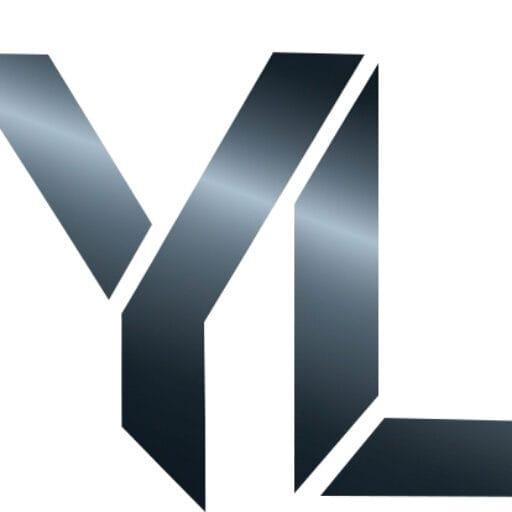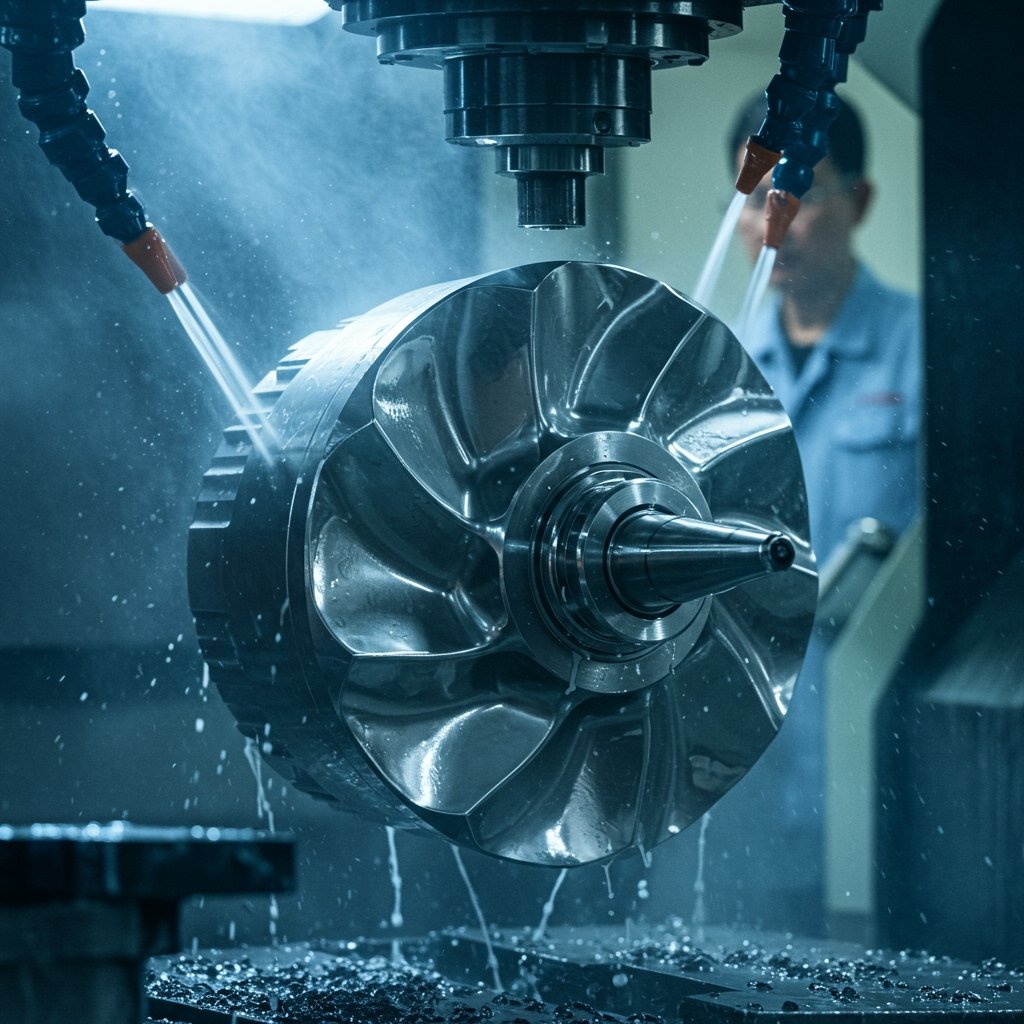CNC machining of C61400 and C63000 aluminum bronze alloys is a specialized process that leverages their unique combination of high strength, excellent wear resistance, and corrosion resistance. These materials are chosen for demanding applications in industries such as aerospace, marine, and heavy machinery. Effective CNC machining requires precise control over tool selection, cutting parameters, and thermal management to maintain material integrity, achieve tight tolerances, and deliver superior surface finishes, ultimately maximizing the wear-resistant properties inherent in these robust alloys. Our expertise ensures components meet stringent performance requirements, providing a reliable solution for critical applications.
Article Introduction
- PAS Lead Paragraph: Addressing Aluminum Bronze CNC Machining Challenges
- Understanding C61400 and C63000 Aluminum Bronze Alloys for CNC Machining
- Navigating the Challenges of CNC Machining C61400 and C63000 Alloys
- Achieving High Strength and Wear Resistance through Expert CNC Machining
- Quality Control and Surface Finish in C61400 and C63000 CNC Machining
- Addressing Delivery and Project Management in C61400 and C63000 CNC Projects
- Comprehensive After-Sales Support for C61400 and C63000 CNC Machined Parts
Problem: Many manufacturers struggle with the precise and efficient CNC machining of challenging materials like C61400 and C63000 aluminum bronze. Their inherent hardness, abrasiveness, and thermal characteristics can lead to rapid tool wear, poor surface finish, and compromised part integrity, directly impacting performance and longevity.
Agitate: Subpar machining not only wastes valuable material and time but also results in components that fail to meet critical strength and wear resistance specifications. This leads to costly rework, project delays, and ultimately, a loss of trust in the supply chain, hindering your ability to deploy high-performance parts.
Solve: At ly-machining in Shenzhen, we possess the deep expertise and advanced CNC machining capabilities required to meticulously process C61400 and C63000 aluminum bronze. Our proven methodologies ensure optimal material performance, superior surface quality, and adherence to the tightest tolerances, guaranteeing the high strength and wear resistance your applications demand. We transform these challenging alloys into precision components that truly perform.
At ly-machining, our commitment is to provide solutions that overcome these obstacles, ensuring every C61400 and C63000 component we produce delivers exceptional value and performance.
***
Introduction
In the demanding landscape of modern industrial applications, the choice of material is paramount to component longevity and operational reliability. Aluminum bronze alloys, particularly C61400 and C63000, stand out due to their exceptional combination of high strength, remarkable wear resistance, and superior corrosion resistance. We understand their critical role.
However, harnessing these inherent properties into precision components requires advanced CNC machining expertise. These alloys present unique challenges that demand specialized knowledge in tool selection, cutting parameters, and process control. Our experience confirms this.
This article delves into our methodologies for the CNC machining of C61400 and C63000, focusing on how we overcome these challenges to consistently deliver parts with optimal mechanical properties and surface finishes. We aim to share our insights into achieving high strength and wear resistance effectively.
Our discussion will cover material characteristics, machining strategies, quality control, and the critical importance of effective project management and after-sales support. We provide a comprehensive view from a practitioner’s perspective.
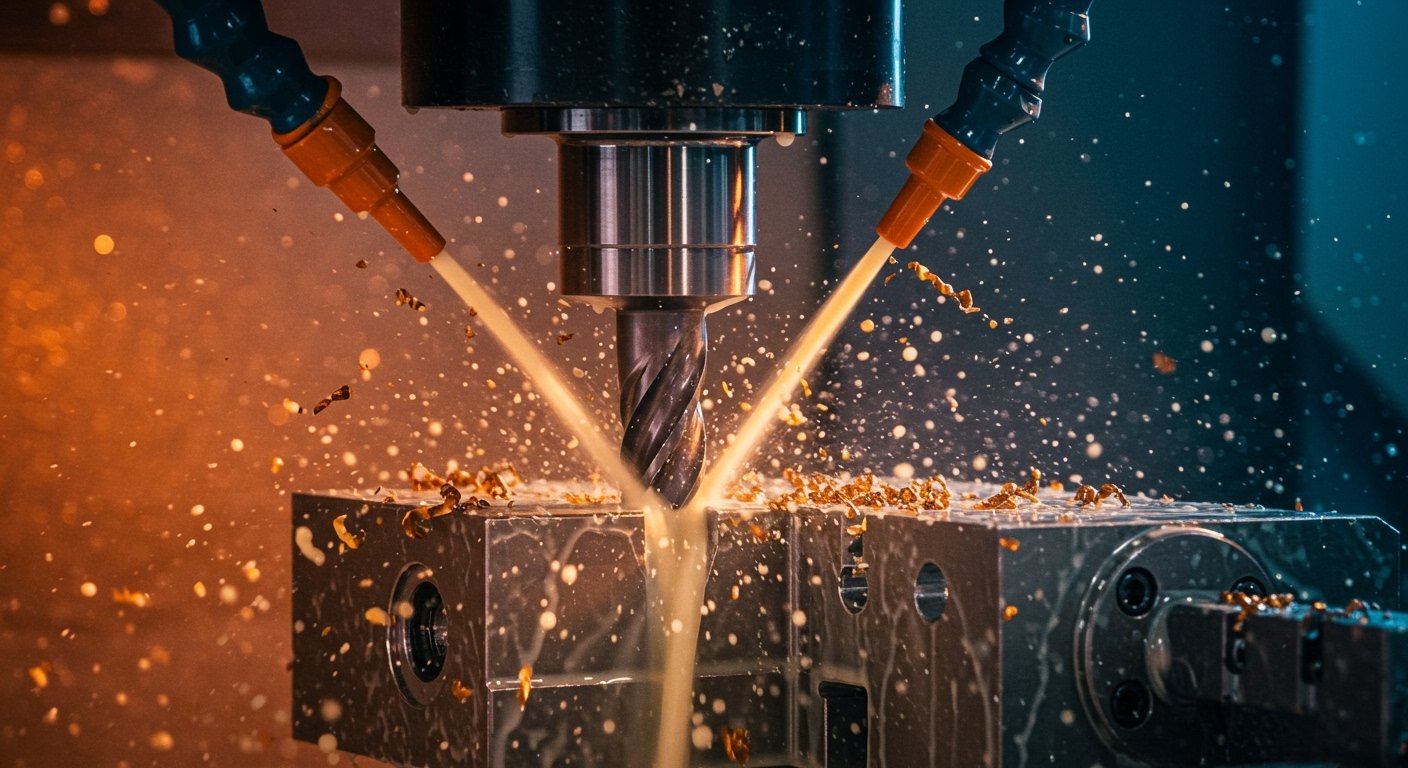
Understanding C61400 and C63000 Aluminum Bronze Alloys for CNC Machining
The foundation of successful CNC machining lies in a profound understanding of the material’s metallurgical properties. C61400 and C63000 aluminum bronze alloys are complex, offering distinct advantages that make them suitable for specific high-performance applications. We study these closely.
Our experience in Shenzhen has taught us that recognizing these nuances is the first step towards developing an effective machining strategy. Each alloy presents a unique profile that influences everything from tool life to surface integrity. We treat them accordingly.
Key Properties of C61400 for CNC Machining
C61400, often referred to as Aluminum Bronze D, is an excellent choice for applications requiring good strength and resistance to corrosion and wear. Its composition typically includes copper, aluminum, and small amounts of iron. We value its balanced characteristics.
This alloy exhibits a reasonable level of machinability compared to other high-strength bronzes, but it still demands careful consideration during CNC operations. Its microstructure contributes to its robust nature.
We find that C61400 maintains good ductility, which can sometimes lead to chip curling and entanglement if cutting parameters are not precisely controlled. This is a common challenge we address proactively.
Its resistance to oxidation and stress corrosion cracking makes it highly desirable for marine and industrial environments. We frequently recommend it for these demanding settings.
Thermal conductivity is moderate, meaning heat generated during CNC machining must be managed effectively to prevent thermal distortion and achieve dimensional accuracy. Our cooling strategies are tailored for this.
Key Properties of C63000 for CNC Machining
C63000, known as Nickel Aluminum Bronze (NAB), represents a significant step up in strength and hardness, primarily due to the addition of nickel. It is a workhorse alloy for critical applications.
This alloy’s composition typically includes copper, aluminum, iron, and nickel, with nickel enhancing its mechanical properties and corrosion resistance, especially in seawater. Its performance is often superior.
The increased hardness and tensile strength of C63000 make it more challenging to machine than C61400, requiring more robust tooling and carefully optimized cutting conditions. This demands our specialized expertise.
Despite its toughness, C63000 offers excellent resistance to cavitation erosion, making it ideal for propellers, pump components, and valve seats. We machine these parts regularly.
Its high strength-to-weight ratio and ability to retain properties at elevated temperatures are crucial for aerospace and heavy equipment industries. We leverage these characteristics for our clients.
The machinability of C63000 is generally rated as fair, meaning tool wear can be significant without proper planning and execution in CNC machining. We prioritize tool life optimization.
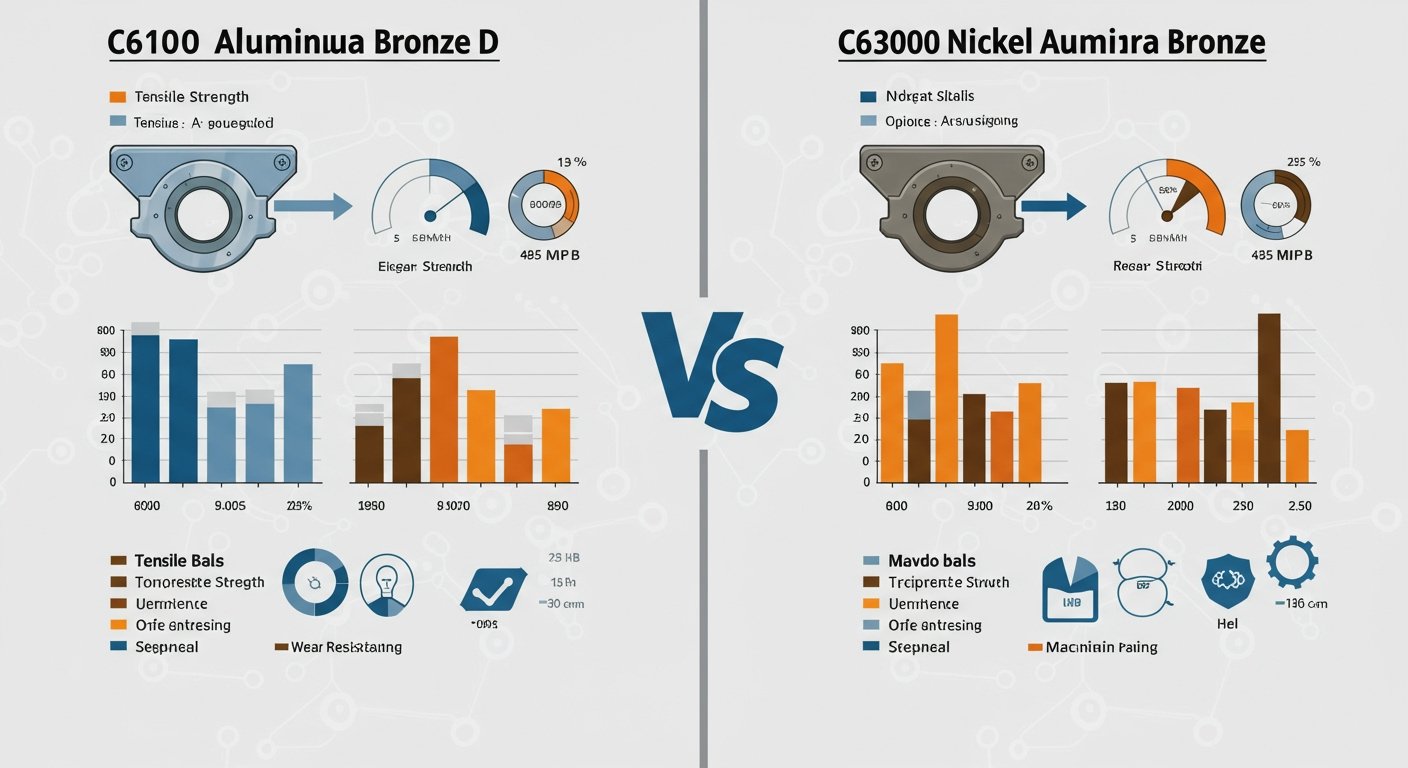
| Property/Characteristic | C61400 (Aluminum Bronze D) | C63000 (Nickel Aluminum Bronze) |
|---|---|---|
| Primary Alloying Elements | Copper, Aluminum, Iron | Copper, Aluminum, Iron, Nickel |
| Tensile Strength (Min) | 485 MPa (70 ksi) | 690 MPa (100 ksi) |
| Yield Strength (Min) | 170 MPa (25 ksi) | 380 MPa (55 ksi) |
| Hardness (Typical HB) | 135 HB | 200 HB |
| Wear Resistance | Good | Excellent |
| Corrosion Resistance | Very Good | Excellent |
| Machinability Rating | Good (approx. 20% of free-machining brass) | Fair (approx. 10% of free-machining brass) |
| Applications | Bushings, bearings, valve stems, pump parts | Gears, marine hardware, aircraft components, critical bearings |
| Key Advantage | Balanced strength and corrosion resistance | Superior strength, hardness, and resistance to cavitation |
Navigating the Challenges of CNC Machining C61400 and C63000 Alloys
Our extensive experience in Shenzhen with CNC machining aluminum bronze has highlighted specific challenges that require expert navigation. These alloys, while highly beneficial, are not always straightforward to process. We have developed refined strategies to address each obstacle systematically.
The inherent properties of C61400 and C63000, such as their toughness, abrasiveness, and propensity for work hardening, demand a meticulous approach to every aspect of the machining process. Our team understands these complexities deeply.
Without proper attention, these characteristics can lead to accelerated tool wear, inconsistent surface finishes, and dimensional inaccuracies. We prioritize preventing these issues.
Tool Selection and Strategies for C61400 and C63000 CNC Machining
Choosing the correct tooling is paramount when CNC machining C61400 and C63000. The high hardness and abrasive nature of these alloys can rapidly degrade cutting edges if unsuitable tools are used. We invest in high-performance tooling.
We consistently opt for tools made from high-quality carbide, often with advanced coatings such as TiAlN or AlCrN, which significantly enhance wear resistance and reduce friction. This extends tool life and improves surface quality.
For C66300, which is tougher, we often lean towards tools with slightly negative rake angles to provide more support to the cutting edge, mitigating chipping. However, a positive rake angle is generally preferred for C61400 for cleaner cutting.
Tool geometry, including helix angle and chip breaker design, is carefully selected to promote efficient chip evacuation and reduce the risk of chip recutting or entanglement. This prevents surface defects.
We regularly review and update our tool library, incorporating the latest advancements in cutting tool technology to maintain our competitive edge in CNC machining. Continuous improvement is key.
| Tool Material | Coating (Recommended) | Rake Angle (General) | Notes on Application |
|---|---|---|---|
| Solid Carbide | TiAlN, AlCrN | Positive (C61400), Slightly Negative (C63000) | Provides excellent hardness and wear resistance; first choice for most operations. |
| Coated Cermet | TiCN | Positive | Good for finishing passes, offering better surface finish. |
| PCD (Polycrystalline Diamond) | None | Positive/Neutral | Extremely hard, ideal for very high wear resistance demands, high production runs, or very abrasive grades. (High initial cost) |
| HSS (High-Speed Steel) | TiN | Positive | Less common for C61400/C63000 due to rapid wear; sometimes used for interrupted cuts or very specific geometries at lower speeds. |
Optimizing Cutting Parameters for Precision C61400 and C63000 Machining
Optimizing cutting parameters is a delicate balance that directly impacts part quality, tool life, and machining efficiency when working with C61400 and C63000. Our approach is data-driven and iterative.
We typically employ lower cutting speeds and higher feed rates compared to softer materials to ensure a robust chip formation and reduce heat build-up at the cutting edge. This minimizes work hardening.
For C61400, we aim for moderate cutting speeds and feeds that allow for good chip control without inducing excessive heat. Our goal is a continuous but manageable chip.
When machining the harder C63000, we prioritize maintaining consistent cutting forces to prevent vibration and maintain tool stability, often opting for even lower cutting speeds. This prolongs tool life.
Depth of cut is also critical; a sufficient depth ensures the tool engages beneath any previously work-hardened surface, promoting more stable cutting conditions. We analyze each pass meticulously.
We continuously monitor spindle load, tool deflection, and chip characteristics during the CNC machining process, making real-time adjustments to maintain optimal performance. This adaptive strategy is essential.
| Parameter | C61400 (General Guideline) | C63000 (General Guideline) | Notes on Adjustment |
|---|---|---|---|
| Cutting Speed (Vc) | 60-120 m/min (200-400 SFM) | 45-90 m/min (150-300 SFM) | Lower speeds for C63000 to manage heat and tool wear. |
| Feed Rate (fz) | 0.15-0.30 mm/rev (0.006-0.012 ipr) | 0.10-0.25 mm/rev (0.004-0.010 ipr) | Higher feed rates (within limits) can reduce work hardening. |
| Axial Depth of Cut (ap) | 0.5-5.0 mm (0.02-0.2 inch) | 0.2-3.0 mm (0.008-0.12 inch) | Deeper cuts prevent rubbing; adjust for rigidity. |
| Radial Depth of Cut (ae) | 0.1-1.0 mm (0.004-0.04 inch) | 0.05-0.5 mm (0.002-0.02 inch) | Lighter radial cuts for C63000 in finishing to manage forces. |
| Coolant Type | High-pressure soluble oil or synthetic | High-pressure soluble oil or synthetic | Crucial for chip evacuation and thermal control. |
Effective Chip Management in C61400 and C63000 CNC Processes
Efficient chip management is often underestimated but plays a vital role in the success of CNC machining C61400 and C63000. Poor chip evacuation can lead to tool breakage and surface imperfections. We prioritize this aspect.
These aluminum bronze alloys tend to produce stringy or tough chips, which can easily wrap around the tool or workpiece, causing significant issues. We design our processes to mitigate this.
Our strategies include selecting tools with appropriate chip breaker geometries that fracture chips into smaller, more manageable segments. This prevents entanglement and facilitates removal.
High-pressure coolant delivery systems are essential for flushing chips away from the cutting zone, maintaining a clear path for the tool and preventing recutting. We employ these systems routinely.
We also consider the machining orientation and fixturing to aid in gravitational chip evacuation where possible, especially for deeper pockets or intricate geometries. Every detail matters.
Regular cleaning cycles and automated chip conveyors are integrated into our production lines to ensure a continuously clear machining environment. This supports uninterrupted operation.
Thermal Control and Coolant Strategies for CNC Machining Aluminum Bronze
Effective thermal control is critical when CNC machining C61400 and C63000, as excessive heat can lead to material distortion, accelerated tool wear, and compromised surface integrity. We address heat generation proactively.
Aluminum bronze alloys have moderate thermal conductivity, meaning heat can accumulate at the cutting zone if not properly dissipated. This requires a robust cooling strategy.
We primarily utilize high-pressure soluble oil or synthetic coolants, which provide superior lubrication and heat transfer capabilities compared to simple flood coolants. These are our go-to solutions.
The high-pressure delivery of coolant not only cools the cutting edge but also helps to break and evacuate chips, preventing thermal shock to the tool and workpiece. This dual action is beneficial.
For particularly challenging applications, we may explore cryogenic cooling or minimum quantity lubrication (MQL) techniques, though standard high-pressure coolant is effective for most scenarios. We adapt our methods.
Monitoring workpiece temperature and tool wear regularly allows us to fine-tune coolant flow and pressure, ensuring optimal thermal management throughout the entire CNC machining process. This adaptive control is part of our expertise.
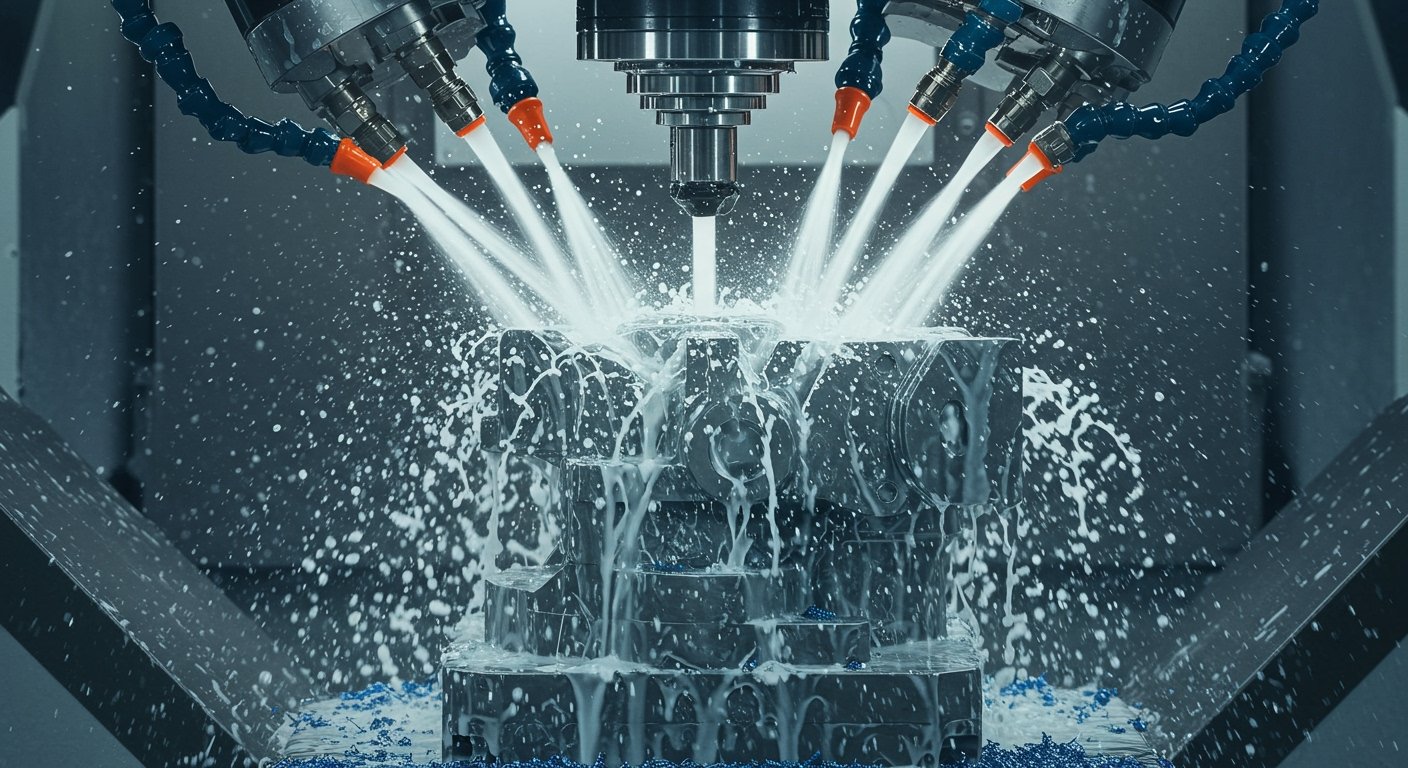
Achieving High Strength and Wear Resistance through Expert CNC Machining
The ultimate goal of CNC machining C61400 and C63000 is to produce components that fully leverage their inherent high strength and wear-resistant properties. Our processes are engineered to enhance these characteristics, not diminish them.
Poor machining practices can induce surface stresses, microcracks, or metallurgical changes that compromise the material’s performance. We meticulously avoid such pitfalls.
Our expertise ensures that the machined parts retain their robust mechanical integrity, ready to perform reliably in the most demanding environments. This is a testament to our precision.
Maintaining Material Integrity during C61400 and C63000 CNC Operations
Maintaining the metallurgical integrity of C61400 and C63000 during CNC operations is crucial for preserving their high strength and wear resistance. We focus on process stability.
Excessive cutting forces or localized heating can lead to work hardening, surface tearing, or even phase transformations, which can degrade the material’s properties. We employ strategies to prevent this.
Our choice of cutting tools, optimized geometries, and carefully selected cutting parameters are all designed to minimize stress and thermal impact on the workpiece. This proactive approach is fundamental.
We ensure tools are always sharp and in excellent condition, as dull tools generate more heat and cutting forces, increasing the risk of material damage. Regular tool inspection is standard.
Precision fixturing and stable machine setups also play a vital role in preventing vibration and chatter, which can cause surface irregularities and micro-fractures. Our setups are rigorously tested.
By controlling these variables, we ensure that the finished component’s microstructure and inherent properties remain uncompromised, delivering maximum performance. This attention to detail defines our work.
Post-Machining Treatments to Enhance Wear Resistance of C61400 and C63000
While the inherent properties of C61400 and C63000 provide excellent wear resistance, certain post-machining treatments can further enhance their surface durability and extend component life. We advise clients on these options.
For applications requiring extreme wear resistance, surface hardening processes like nitriding or chrome plating can be applied to aluminum bronze components. This creates a hard outer layer.
However, it is crucial to select treatments compatible with the aluminum bronze alloy and its specific application, as not all surface treatments are suitable. Our metallurgists offer guidance.
Stress relieving, through heat treatment, can be performed after extensive machining to remove residual stresses induced during the cutting process. This prevents potential deformation or cracking.
We also offer specialized surface finishing processes, such as polishing or honing, to achieve ultra-smooth surfaces that reduce friction and improve wear characteristics in dynamic applications. This optimizes performance.
Each post-machining treatment is carefully considered in consultation with the client to ensure it aligns with the component’s functional requirements and operational environment. Our solutions are tailored.
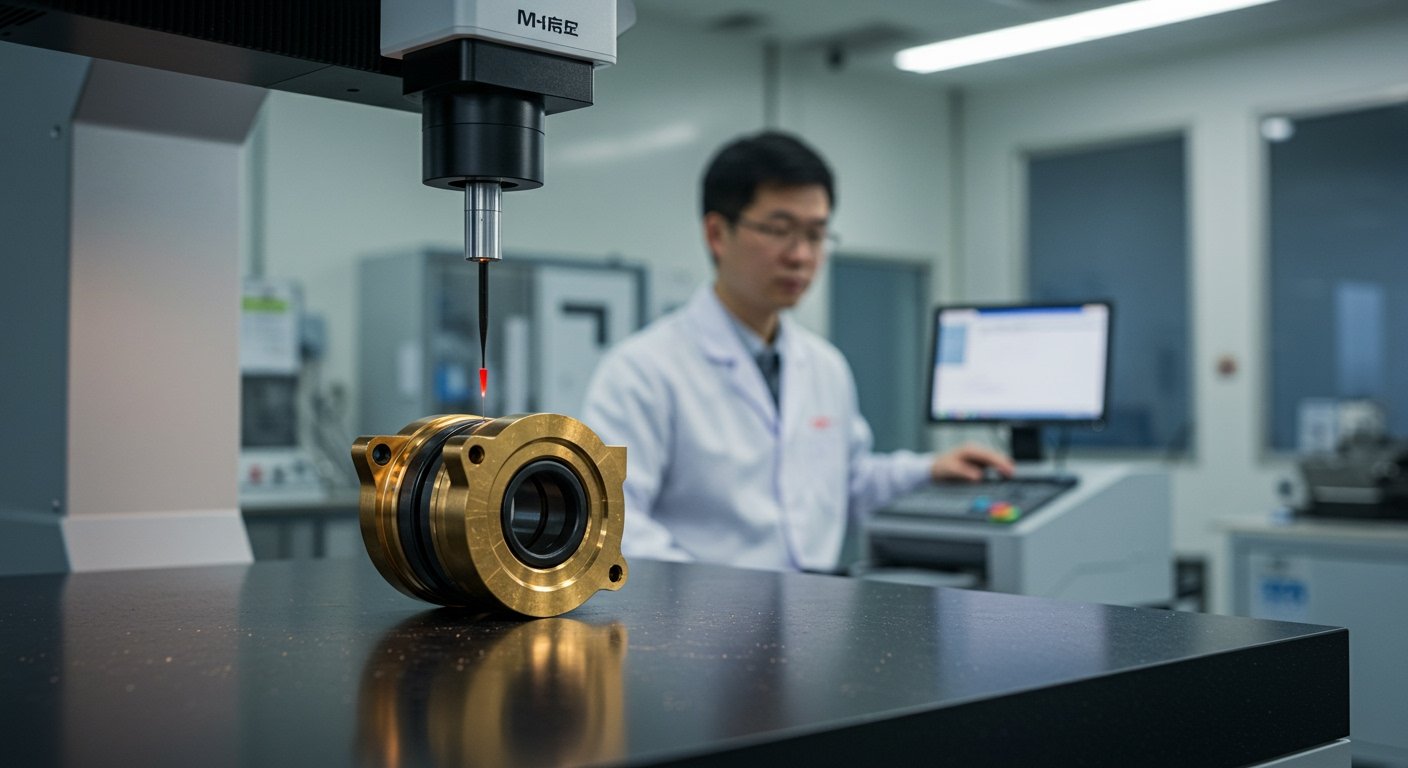
Quality Control and Surface Finish in C61400 and C63000 CNC Machining
Achieving exacting quality standards and superior surface finishes is a hallmark of our CNC machining services for C61400 and C63000 alloys. These aspects are critical for performance and reliability.
Poor surface finish can lead to increased friction, accelerated wear, and premature component failure, especially in dynamic applications. We understand these implications deeply.
Our stringent quality control protocols ensure that every component manufactured in our Shenzhen facility meets or exceeds the required specifications. We leave nothing to chance.
Precision Measurement and Inspection for CNC Machined C61400 Components
Precision measurement and inspection are integral to our quality assurance process for CNC machined C61400 components. We employ a multi-stage approach to verify accuracy.
From the initial setup to the final inspection, we utilize advanced metrology equipment, including Coordinate Measuring Machines (CMMs) and optical comparators. This ensures dimensional accuracy.
In-process measurements are regularly conducted by our skilled technicians to monitor critical dimensions and detect any deviations early, allowing for immediate corrective actions. This prevents waste.
We pay particular attention to ensuring tight tolerances, especially in areas critical for fit, form, and function, such as bearing surfaces or mating interfaces. Precision is paramount.
Surface roughness measurements (Ra, Rz) are performed to verify the achieved surface finish meets specification, using profilometers and other dedicated instruments. We ensure smooth operation.
Comprehensive inspection reports are provided with each batch of C61400 components, offering full traceability and transparency for our clients. Our documentation is thorough.
Attaining Superior Surface Finishes on CNC Machined C63000 Parts
Attaining a superior surface finish on CNC machined C63000 parts requires specialized techniques due to the alloy’s hardness and propensity for work hardening. We have perfected these methods.
Our finishing passes typically involve lighter depths of cut and higher spindle speeds with appropriately chosen tools, aiming for a very fine chip and minimal material displacement. This creates a smooth surface.
We often use tools with specific edge preparations and micro-geometries designed to minimize burr formation and improve the quality of the cut surface. Tool design is key.
The use of high-performance coolants under high pressure is crucial during finishing operations to prevent heat buildup and maintain a consistent, lubricated cutting zone. This optimizes surface quality.
After machining, we may employ additional processes such as vibratory finishing, abrasive flow machining, or even hand polishing for specific high-precision surfaces where required. We offer a range of options.
Our team has extensive experience in identifying the optimal combination of machining parameters and post-processing steps to achieve the desired surface finish for C63000, from functional smoothness to aesthetic requirements. We deliver on expectations.
Addressing Delivery and Project Management in C61400 and C63000 CNC Projects
Beyond technical prowess, effective project management and reliable delivery are crucial pain points for clients seeking CNC machining services. We recognize that timely and consistent service is as important as technical excellence. Our robust systems in Shenzhen address this directly.
We understand that delays in component delivery can disrupt production schedules and increase costs for our clients. Therefore, we prioritize transparent communication and efficient planning.
Our commitment to project excellence extends from the initial quote through to the final delivery, ensuring a seamless and predictable experience. We manage expectations proactively.
Streamlined Production Planning for Timely C61400 and C63000 Deliveries
Our streamlined production planning process is designed to ensure timely deliveries of C61400 and C63000 CNC machined components. We begin with a detailed project assessment.
Upon receiving an order, our engineering team conducts a thorough review of specifications, identifying potential manufacturing bottlenecks and developing a precise production schedule. This early planning is critical.
We employ advanced Manufacturing Execution Systems (MES) and Enterprise Resource Planning (ERP) software to manage material procurement, allocate machine resources, and track progress in real-time. This provides visibility.
Our strong relationships with raw material suppliers ensure a consistent and reliable supply of C61400 and C63000 alloys, mitigating potential delays in the supply chain. We build trusted partnerships.
Preventative maintenance programs for our CNC machines minimize unexpected downtime, further contributing to our ability to meet committed delivery dates. Machine reliability is paramount.
We also build in contingency plans for unforeseen circumstances, allowing us to adapt quickly and minimize any impact on delivery schedules. Flexibility is a core strength.
Proactive Communication in Complex CNC Machining Engagements
Proactive and transparent communication is a cornerstone of our project management philosophy for complex C61400 and C63000 CNC machining engagements. We keep our clients informed every step of the way.
From the moment a project begins, we assign a dedicated project manager who serves as a single point of contact for all client inquiries and updates. This simplifies communication.
Regular progress reports, including status updates, production milestones, and any potential issues, are provided to clients through their preferred communication channels. We maintain full transparency.
Should any technical challenges or material availability issues arise, we immediately communicate with the client, proposing solutions and discussing alternative approaches. Collaboration is key.
Our team is always accessible to answer questions, provide technical insights, and offer updates, ensuring clients feel fully informed and confident in our ability to deliver. We foster trust.
This commitment to open dialogue helps build strong, lasting partnerships, essential for the successful execution of high-stakes CNC machining projects involving C61400 and C63000. We value long-term relationships.
Comprehensive After-Sales Support for C61400 and C63000 CNC Machined Parts
Our commitment to client satisfaction extends well beyond the delivery of C61400 and C63000 CNC machined parts. We understand that effective after-sales support is crucial for building enduring trust and ensuring long-term success. Our Shenzhen team is dedicated to this.
We believe that our partnership with clients truly flourishes when we stand by the quality and performance of our components throughout their operational life. This is a core value.
Our after-sales support system is designed to provide rapid assistance and valuable insights, addressing any concerns that may arise post-delivery. We are here to help.
Our Commitment to Post-Delivery C61400 and C63000 Support
Our commitment to post-delivery C61400 and C63000 support ensures that clients have a reliable resource for any inquiries or challenges. We stand behind our work.
If any performance issues or concerns arise after the components are in use, our technical support team is readily available to provide expert troubleshooting and analysis. We act swiftly.
We maintain comprehensive records of each project, including material certifications, machining parameters, and inspection data, to facilitate efficient problem diagnosis if needed. Our documentation is meticulous.
For critical applications, we can offer on-site consultation or collaborate remotely to understand the operational environment and provide tailored recommendations. We offer flexible support.
Our goal is not just to deliver parts, but to ensure they perform optimally in your specific application, contributing to your system’s overall reliability and efficiency. We focus on true value.
This proactive and responsive support system underscores our dedication to being a dependable partner in your supply chain for high-performance C61400 and C63000 components. We aim for complete satisfaction.
Continuous Improvement in Aluminum Bronze CNC Machining Services
At ly-machining, continuous improvement is an embedded principle in our approach to aluminum bronze CNC machining services, including C61400 and C63000. We constantly seek enhancements.
We actively solicit feedback from our clients regarding component performance, delivery experience, and overall satisfaction, using this input to refine our processes. Client input is invaluable.
Our engineering and production teams regularly review project outcomes, identify areas for optimization, and implement improvements in tooling, programming, and quality control. This iterative process drives excellence.
We invest in ongoing training for our technicians and engineers, ensuring they remain at the forefront of CNC machining technologies and best practices for challenging alloys. Knowledge is power.
Research and development efforts are directed towards exploring new cutting tool materials, machining strategies, and surface treatments that can further enhance the strength and wear resistance of C61400 and C63000. Innovation is key.
This unwavering commitment to continuous improvement ensures that ly-machining remains a leader in providing cutting-edge and reliable CNC machining solutions for aluminum bronze alloys. We strive for perfection.
Typical Applications Benefiting from CNC Machining C61400 and C63000
The superior properties of C61400 and C63000 aluminum bronze, coupled with our expert CNC machining capabilities, make them indispensable for a wide range of demanding applications. We see them in critical roles across many industries.
Our Shenzhen facility frequently produces components for sectors where reliability, longevity, and performance under harsh conditions are non-negotiable. These alloys are often the only viable choice.
Understanding the specific application requirements is crucial for selecting the correct alloy and optimizing the CNC machining process for maximum benefit. We work closely with our clients to define these.
Industrial Applications of C61400 CNC Components
CNC machined C61400 components find extensive use in various industrial applications due to their good strength, corrosion resistance, and reasonable machinability. We provide parts for many systems.
This alloy is commonly used for bushings, bearings, and wear plates where moderate loads and good wear characteristics are required. Its balance of properties is ideal here.
In the marine industry, C61400 is specified for valve stems, pump components, and propeller nuts due to its excellent resistance to saltwater corrosion and erosion. It withstands harsh environments.
We also machine C61400 for structural components in chemical processing equipment, where its resistance to various corrosive media is a significant advantage. This ensures process integrity.
It is also found in heavy machinery, such as in certain gears and hydraulic components, offering a robust alternative to less durable materials. Its reliability is valued here.
Our ability to precisely CNC machine C61400 ensures that these critical industrial components perform reliably and contribute to the overall efficiency and lifespan of complex systems. We enable high performance.
High-Performance Uses for C63000 CNC Machined Parts
C63000, with its superior strength, hardness, and wear resistance, is reserved for the most demanding, high-performance applications where C61400 might not suffice. Our CNC machining expertise unlocks its full potential.
In the aerospace industry, C63000 is often selected for landing gear bushings, engine components, and structural parts where high loads and wear resistance are paramount. Safety and reliability are critical.
Marine applications extensively use CNC machined C63000 for high-stress components like propeller hubs, shafting, and critical pump impellers due to its exceptional resistance to cavitation erosion and corrosion. It survives extreme forces.
Heavy equipment and mining machinery benefit from C63000 in gears, valve guides, and critical wear parts, where it withstands abrasive conditions and heavy impact loads. Its durability is unmatched.
It is also prevalent in oil and gas exploration equipment, including downhole tooling and valve components, where it resists harsh chemicals, high pressures, and extreme temperatures. It operates under pressure.
Our precision CNC machining of C63000 ensures that these components meet the most rigorous performance standards, providing unmatched reliability in highly critical environments. We deliver uncompromising quality.
Conclusion
The CNC machining of C61400 and C63000 aluminum bronze alloys represents a specialized field where deep material knowledge, advanced tooling strategies, and precise process control are indispensable. At ly-machining in Shenzhen, we have cultivated this expertise over many years.
We understand that our clients require more than just parts; they need reliable, high-performance components that excel in strength and wear resistance, meet stringent quality standards, and are delivered on schedule. Our approach is holistic.
By meticulously addressing every aspect from tool selection and parameter optimization to chip management and thermal control, we ensure the material’s inherent properties are fully realized in the finished product. We make no compromises on quality.
Our commitment extends to comprehensive quality control, proactive project management, and unwavering after-sales support, cementing our role as a trusted partner in high-precision manufacturing. We build lasting relationships.
When your applications demand the unparalleled strength and wear resistance of C61400 and C63000 aluminum bronze, precisely CNC machined to your specifications, ly-machining is your reliable solution. We are ready to bring your designs to life.
Related Questions/FAQ
1. What are the key differences in machinability between C61400 and C63000 for CNC operations?
C61400 generally offers better machinability due to its lower hardness and strength compared to C63000. It produces slightly more manageable chips, allowing for moderate cutting speeds. C63000, being a tougher nickel aluminum bronze, demands lower cutting speeds, more robust tooling, and very precise control over feed rates to mitigate rapid tool wear and prevent work hardening. Our experience dictates a more aggressive but controlled approach for C61400, while C63000 requires greater caution and specialized tooling.
2. How do you ensure the high wear resistance of C61400 and C63000 is maintained or enhanced during CNC machining?
We ensure high wear resistance by maintaining material integrity throughout the CNC machining process. This involves selecting sharp, high-quality carbide tools with appropriate coatings and geometries to minimize heat generation and cutting forces, preventing micro-fractures or work hardening that could compromise surface hardness. Additionally, we optimize cutting parameters and use high-pressure coolants for thermal control. For specific applications, we can suggest post-machining treatments like stress relieving or surface finishing (polishing, honing) to further enhance surface durability and overall wear performance.
3. What specific quality control measures does ly-machining implement for C61400 and C63000 CNC components in Shenzhen?
At ly-machining in Shenzhen, our quality control for C61400 and C63000 CNC components is rigorous. We employ a multi-stage process that includes initial material certification verification, in-process inspection using precision instruments like calipers, micrometers, and bore gauges, and final inspection with advanced metrology equipment such as CMMs and optical comparators. Surface finish is verified with profilometers. We also conduct visual inspections for surface defects, ensure adherence to tight dimensional tolerances, and provide comprehensive inspection reports with full traceability for every batch.
